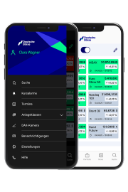ETFs: Renewed interest in European equities
The markets are on the rise again, and there were no major waves of selling on the ETF market anyway. Now, attention is increasingly turning to Europe—and to emerging markets. They have performed extremely well this year.
11 November 2025. FRANKFURT (Frankfurt Stock Exchange). The mood has changed, and confidence is back. This is because an end to the shutdown in the US is looking more and more likely. Yesterday, Monday, Wall Street was heading back toward its record highs from the end of October. And on Tuesday afternoon, the DAX stood at just under 24,000 points – after falling below 23,500 points last week.
“The markets are looking back on a difficult week. All stock indices have lost ground, especially the US ones,” reports Holger Heinrich, who trades ETFs for Baader Bank. For the week as a whole, he reports a significant increase in turnover and a more or less balanced ratio of purchases to sales. Frank Mohr of Société Générale, on the other hand, still sees a clear buyer surplus. “However, this is also related to the beginning of the month and savings plans, especially for MSCI and S&P 500 ETFs,” he notes.
Focus on major US and global indices
According to Mohr, S&P 500, MSCI USA, MSCI World, and FTSE All World trackers, such as those from iShares, Vanguard, SPDR, or Amundi, are particularly in demand. “The focus for US equities is on broadly diversified and factor-based strategies,” Heinrich notes. The shopping list includes, for example, the Xtrackers S&P 500 (IE000Z9SJA06) and the Active ETF JPMorgan US Value Equity Active (IE000TD3TI26), while the selling list includes core and equal-weight strategies such as the First Trust US Large Cap Core AlphaDEX (IE00B8X9NW27) and the iShares S&P 500 Equal Weight (IE000MLMNYS0). According to Heinrich, the picture is also mixed globally, with ESG and sustainability themes remaining in focus. On the buy side is the iShares MSCI ACWI SRI (IE000JTPK610), while on the sell side is the Amundi MSCI World ESG Selection (IE00016PSX47).
European equities: “There appears to be potential for catch-up here”
European equities are also a topic of discussion. “At 12 percent, their share of sales is higher than usual for us. There appears to be potential for catch-up here,” Mohr notes. The iShares Core MSCI Europe (IE00B4K48X80) and Stoxx Europe 600 trackers from iShares (DE0002635307) and Amundi (LU0908500753) are doing well, for example. Heinrich reports purchases on the European market with a focus on value and large indices and sales of broadly diversified and dividend-oriented products. There is also a lot of activity in the Asian equity business, as Andreas Schröer from Lang & Schwarz observes. “For example, Japanese equities are recording higher than usual turnover in both directions.”
Emerging markets index: up almost 30 percent
According to Schröer, emerging market ETFs also remain in demand, such as the iShares Core MSCI EM (IE00BKM4GZ66). Société Générale is also seeing more purchases than sales, for example in products from iShares and Amundi. Although the MSCI Emerging Markets index also lost ground in the first few days of November, it has recently rebounded. The latest records are thus within reach again. Since the beginning of the year, the index has gained almost 30 percent.

Which EM index is better?
The two major emerging market indices, MSCI Emerging Markets and MSCI Emerging Markets IMI (Investable Market Index), differ primarily in the number of components they include: While MSCI Emerging Markets tracks 1,190 companies (85 percent of market capitalization), MSCI Emerging Markets IMI tracks 3,125 companies, more than twice as many (99 percent of market capitalization). However, the differences are not significant: the top ten lists of both indices are identical, with Taiwan Semiconductor, Tencent, Alibaba, Samsung, and SK Hynix as the heavyweights. The country weightings are also very similar, with China, Taiwan, and India by far the largest countries. In terms of performance this year and over a three-year period, the MSCI Emerging Markets has performed slightly better, but over the very long term since 2000, the MSCI Emerging Markets IMI has outperformed.

Tech sector: Profit-taking too
Last week, healthcare ETFs were the exception, but now tech trackers are once again dominating trading in sector ETFs. “However, there is also some profit-taking, with purchases only slightly outweighing sales,” Mohr notes. He sees inflows for the Xtrackers Artificial Intelligence & Big Data (IE00BGV5VN51) and the iShares S&P 500 Information Technology (IE00B3WJKG14), but outflows from the Amundi MSCI World Information Technology (LU0533033667). “The high level of interest in cybersecurity is also striking,” he adds. Examples include the iShares Digital Security (IE00BG0J4C88) and First Trust Nasdaq Cybersecurity (IE00BF16M727). The previously popular silver mining ETFs, specifically Global X Silver Miners (IE000UL6CLP7), are no longer in such high demand.
Focus on money market, rising crypto sales
Business with bond ETFs is rather quiet, with the category accounting for only 20 percent of Société Générale's turnover. The focus remains on money market and money market-related trackers (IE000RHYOR04, LU0290358497). Apart from that, eurozone government bonds are in demand, as Mohr notes.
The slide in the crypto market also led to rising sales of crypto ETNs, as Schröer from Lang & Schwarz reports. Bitcoin slipped below the $100,000 mark last week, but is now back at just under $105,000. At its peak, however, the currency had cost over $125,000. “We tend to trade second-tier currencies more,” Schröer reports.
By Anna-Maria Borse, 11 November 2025 © Deutsche Börse AG
About the author
Anna-Maria Borse is a finance and economics editor specializing in financial markets/stock exchanges and economic issues.
Feedback and questions to redaktion@deutsche-boerse.com





